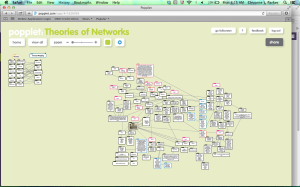For the last MindMap, were were to organize our MindMap by concepts. I started this process by listing all the theorists as a guide. After this process, I stopped because I realized that I do not have any concepts by which to group these theorists. So, I went with the things that come to mind when I think of this course: human agency, non-human agency, tracing, and hierarchy.
http://popplet.com/app/#/1626026
The biggest thing I’ve learned from doing the MindMap and the other blogs is that I learn the way I learn and it works for me. This has been the most challenging semester I’ve ever had in my entire life. Even more so than the semester in which I took 2 PhD level classes, my mom passed, and I taught 2 classes at 3 different schools. This entire semester I have been thinking: “There is something wrong with me. I should not be here. Apparently, I am not smart enough to get a PhD.” It took dealing with the MindMap concepts for me to realize what lies at the heart of my issues is my learning style. I am not a visual learner. I have never been in my 30 years of living. I have no desire to be a visual learner, creating this MindMap did not help me to grapple with the concepts presented in the readings. It obfuscated them. Every week I had to push myself to figure out how to condense and connect the things I’d read in order to do the MindMap. I am linear. I like straight lines. I like lists. I like short/concise annotations or long lists with no complete sentences and no visuals. That is how I learn. I like privacy to try out new ideas. This approach, however closed off and inadequate it may seem to others, got me here. I did the MindMap because I had to do it. Do I understand it: No! Am I glad I did it: Yes! I am glad because now I know for certain what works for me and what doesn’t. The processes (MindMap/ Visualize All the Things) felt like steeple chase from my days of track in high school.

April 29, 2014 at 6:47 am
I appreciate your final reflection on learning style; now, what does that mean to you as an instructor, esp. thinking about how our own learning styles (probably) influence our teaching styles. I too am more of a linear learner; however, I know as I’ve practiced I’ve found visualization helps me think through some things. And, more importantly, I’ve definitely found that some students NEED visualization to learn.
I confess, I wish you had used some of the case study prompts as a way to think of major concepts in the course.
April 29, 2014 at 7:25 am
I interpreted the assignment as a combination of concepts and reflection on the bigger picture of the mindmap. The bigger picture of the mindmap reveled to me my issues with learning style. In regards to your comment on how my learning styles “(probably) influence our teaching styles,” I can say that they do not influence my style. I am very linear. The more visuals are involved the more confused I get. Because I NEED to learn the way I learn in order to be effective, I offer my students visual, linear, and tactile ways of learning. I integrate learning style into the first writing diagnostic to gauge where everyone is. I have always been over cautiously about not boxing my students in. I avoid teaching them the writing process as steps or even as a recursive process because many of them internalize it as this is “the” process I should have. I teach them to develop a process. Maybe they skip freewriting and become experts at revision. Maybe they outline as prewriting, then draft, then do webbing/clustering. It sounds crazy, but I try to cover ALL the things. I even offer index cards so they can “build their” essay if necessary. I am so worried that this will hinder them as writers. I suggest that they try other methods of learning in case they find something that they never knew worked for them. However, if the method doesn’t work for them after a few times, they should stick with what brings results (what clicks). I’m not new to visualizations. I have had to do them in other classes for a grade. I have had to teach online classes that utilize nothing but visualizations. So, I am not against them in any way. I do not deny my students the chance to visualize. I, however, know that this approach is mind boggling to me. I have tried to use the mind map for several assignments. I have even tried to use classmates’ mindmaps that were offered to me as a study tool. Looking at the way things connect visually makes me feel like things are lost and unorganized. My reflection was not an excuse or justification for the lack of major concepts, but my attempt to offer a glimpse into the way my mind works, which I couldn’t express via the mindmap, and why the major concepts while understood could not be expressed that way. I don’t want you to think this was a cop out, I genuinely struggled to make sense/meaning with this to the point where I would panic about doing the mindmap because I felt so confused. If you asked me to write a paper about the major concepts of the course with the theories, I could have it for you tonight (I could possibly make it into a chart). If you ask me to map it or web it or cluster it, I will flounder.